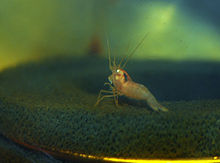| Mirocaris | |
|---|---|

| |
| Mirocaris fortunata | |
| Scientific classification | |
| Domain: | Eukaryota |
| Kingdom: | Animalia |
| Phylum: | Arthropoda |
| Class: | Malacostraca |
| Order: | Decapoda |
| Suborder: | Pleocyemata |
| Infraorder: | Caridea |
| Family: | Alvinocarididae |
| Genus: | Mirocaris Vereshchaka, 1997 |
| Species | |
| |
Mirocaris is a genus of shrimp associated with hydrothermal vents. Sometimes considered the only genus of the family Mirocarididae, Mirocaris is usually placed in the broader family Alvinocarididae. Mirocaris is characterized by a dorsoventrally flattened, non-dentate rostrum, as well as the possession of episodes on the third maxilliped through to the fourth pteropod.[1] The genus contains two species, M. fortunata and M. indica. The two species are found in different oceans, and can be distinguished by the pattern of setation on the claw of the first pereiopod.[1]
Originally, the Mirocaris genus also contained the species M. keldyshi. After the holotype and paratypes of M. fortunata were re-examined in comparison to the paratypes of M. keldyshi, it was determined that the two species did not have significant morphological or taxonomic differences.[2] Newly collected samples (in the late 1990s) from sites around the Mid-Atlantic Ridge obtained by using a slurp gun were also studied in order to confirm these findings.[2] Characteristics such as the number of selutolose spines on the posterior margin of the shrimp’s telson that were initially used to distinguish the two species were re-examined with no statistically significant differences.[2] The name M. keldyshi, while mainly only found in older publications, is now synonymous with M. fortunata.
- ^ a b Komai, Tomoyuki; Martin, Joel W.; Zala, Krista; Tsuchida, Shinji; Hashimoto, Jun (2006-03-30). "A new species of Mirocaris (Crustacea: Decapoda: Caridea: Alvinocarididae) associated with hydrothermal vents on the Central Indian Ridge, Indian Ocean". Scientia Marina. 70 (1): 109–119. doi:10.3989/scimar.2006.70n1109. ISSN 1886-8134.
- ^ a b c Komai, Tomoyuki; Segonzac, Michel (2008). "Taxonomic Review of the Hydrothermal Vent Shrimp Genera Rimicaris Williams & Rona and Chorocaris Martin & Hessler (Crustacea: Decapoda: Caridea: Alvinocarididae)". Journal of Shellfish Research. 27 (1): 21–41. doi:10.2983/0730-8000(2008)27[21:TROTHV]2.0.CO;2. ISSN 0730-8000.